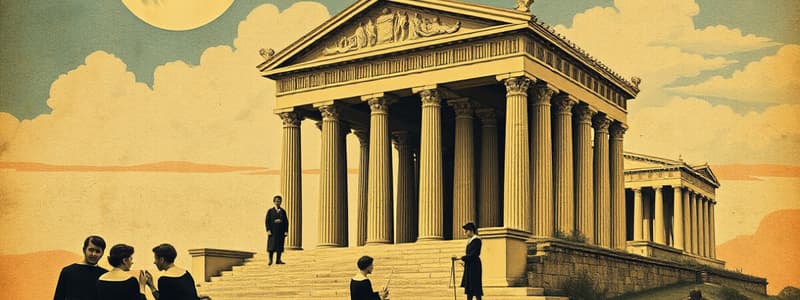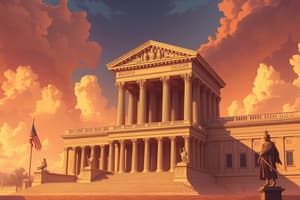Podcast
Questions and Answers
What characterized the early Roman government established after the overthrow of the king?
What characterized the early Roman government established after the overthrow of the king?
- It placed power solely in the hands of the wealthy aristocrats.
- It was a direct democracy allowing all citizens to vote on laws.
- It was a republic where citizens elected their leaders. (correct)
- It was a monarchy concentrated in the hands of a single ruler.
Which of the following best describes the term 'republic' as it pertains to Roman governance?
Which of the following best describes the term 'republic' as it pertains to Roman governance?
- A form of government where citizens indirectly influence political decisions. (correct)
- A system where citizens have no say in government.
- A government run by a single dictator with absolute power.
- A political system where only aristocrats participate in governance.
During which time period did the earliest Romans engage in battles for control of the Italian peninsula?
During which time period did the earliest Romans engage in battles for control of the Italian peninsula?
- 600 to 400 B.C.
- 700 to 200 B.C.
- 500 to 100 B.C.
- 1000 to 500 B.C. (correct)
What was a primary reason for the shift from monarchy to republic in Roman governance?
What was a primary reason for the shift from monarchy to republic in Roman governance?
Which system contrasts with the republic form of government established in Rome?
Which system contrasts with the republic form of government established in Rome?
What significant change did Pericles implement to strengthen democracy in Athens?
What significant change did Pericles implement to strengthen democracy in Athens?
What term describes the Athenian government system where citizens rule and make laws directly?
What term describes the Athenian government system where citizens rule and make laws directly?
What ratio of Athenian residents were actual citizens during the time discussed?
What ratio of Athenian residents were actual citizens during the time discussed?
During which time period did the Greeks successfully defeat the Persian forces?
During which time period did the Greeks successfully defeat the Persian forces?
Which leader is credited with significant advancements in Athenian democracy during the 5th century B.C.?
Which leader is credited with significant advancements in Athenian democracy during the 5th century B.C.?
What was one major outcome of Solon's reforms in 594 B.C.?
What was one major outcome of Solon's reforms in 594 B.C.?
How did Solon's system categorize citizenship in Athens?
How did Solon's system categorize citizenship in Athens?
Who was allowed to hold public office in Athens after Solon's reforms?
Who was allowed to hold public office in Athens after Solon's reforms?
What legal concept did Solon introduce regarding wrongdoers?
What legal concept did Solon introduce regarding wrongdoers?
Which group was omitted from participation in Athenian democracy under Solon's reforms?
Which group was omitted from participation in Athenian democracy under Solon's reforms?
Flashcards are hidden until you start studying
Study Notes
Judicial Branch and Juries
- Juries vary in size, typically composed of 6 to 12 members.
- Trials conducted with paid jurors and are one-day events.
- Defendants and plaintiffs do not have attorneys, nor is there an opportunity for appeals.
Roman Civilization
- The Roman Republic emerged around 509 B.C. after aristocrats overthrew a king.
- Power in the Republic rests with citizens who can elect government leaders.
- A republic is an indirect form of democracy, differing from direct democracy.
Reforms of Solon
- Solon, a prominent Athenian statesman, enacted reforms in 594 B.C. to prevent civil unrest.
- Outlawed slavery due to debt and canceled farmers' debts, stabilizing society.
- Established four classes of citizenship based on wealth, allowing only higher classes to hold office.
- Created the Council of Four Hundred to handle governmental issues and permitted all citizens to bring legal charges.
- Despite reforms, only about 10% of the population were considered citizens; women, slaves, and foreigners were excluded.
Persian Wars and Athenian Democracy
- Between 490 to 479 B.C., Greek city-states united against Persian invasions.
- Athenian democracy thrived during public debates on defense strategies.
- Pericles, a key figure from 461 to 429 B.C., bolstered democracy by paying public officials and jurors, enhancing participation.
Roman Law and Influence
- The Roman legal system aimed to establish uniform justice throughout the Empire, focusing on reason and fairness.
- Principles of Roman law included equality under law, presumption of innocence, and acknowledgment of unreasonable laws.
- The Twelve Tables represented a foundational written legal code, influencing Western legal systems.
Glorious Revolution
- The death of Charles II in 1685 led to the rise of James II, a Catholic monarch.
- James II's rule sparked fears among Protestant citizens regarding a potential return to Catholicism as the state religion.
- The unrest extended to English colonies in America, anticipating a shift in governance dynamics.
Impact of Legal Principles
- The concept of habeas corpus arose to protect individuals from wrongful detention, a principle still vital in democracies today, including in the U.S. Constitution.
Studying That Suits You
Use AI to generate personalized quizzes and flashcards to suit your learning preferences.




